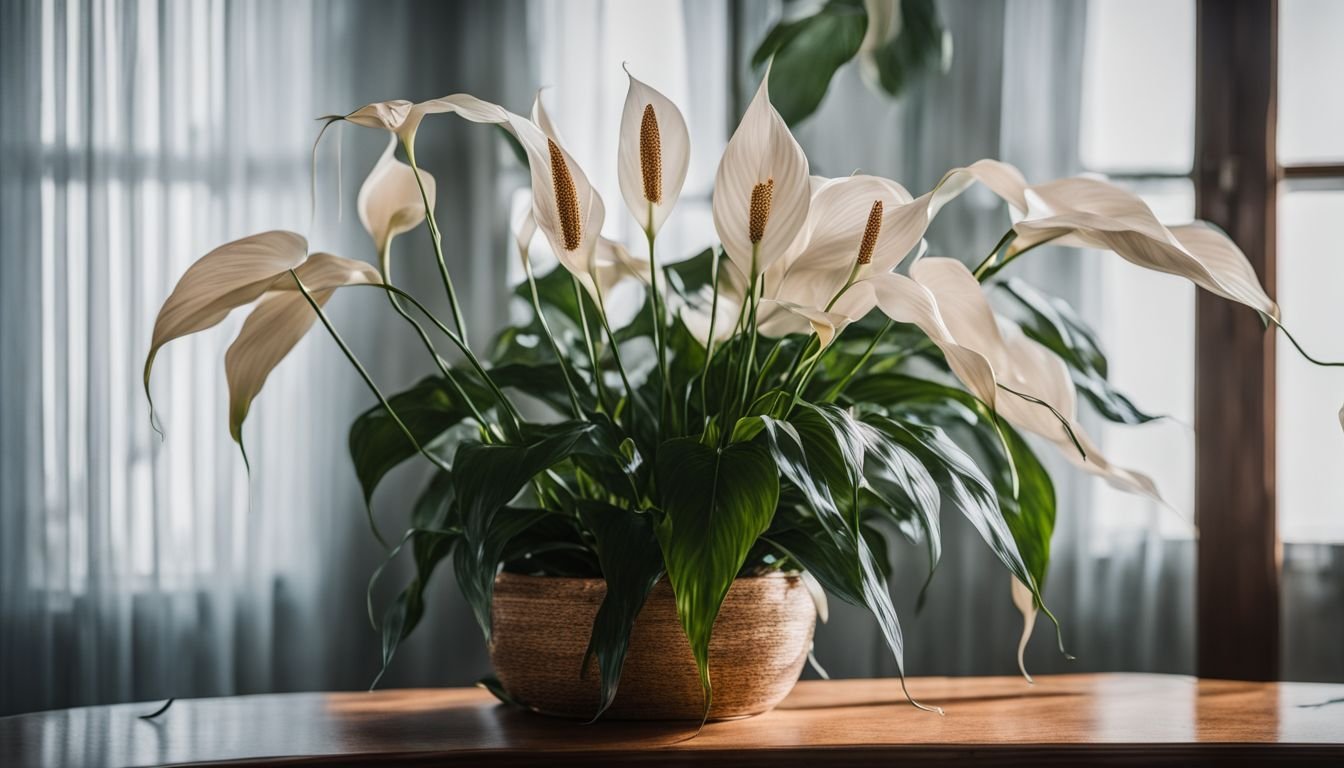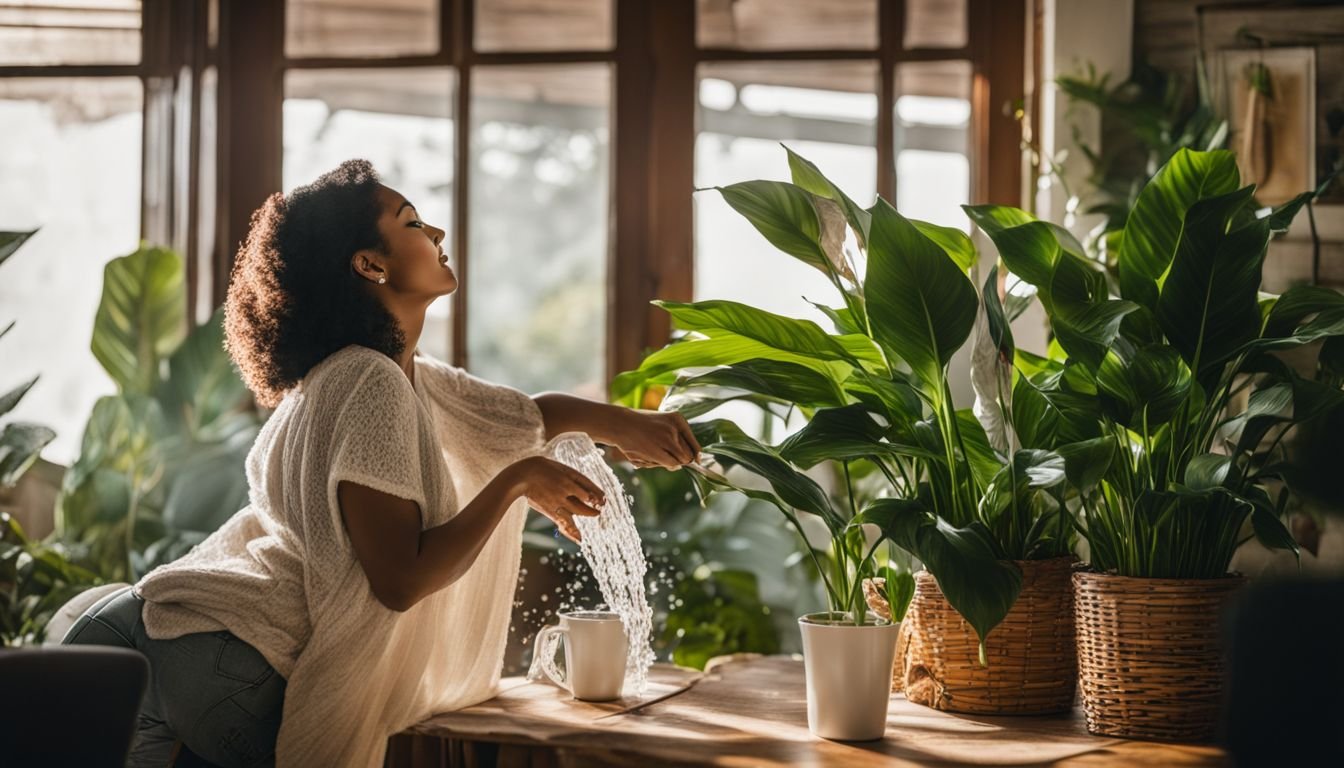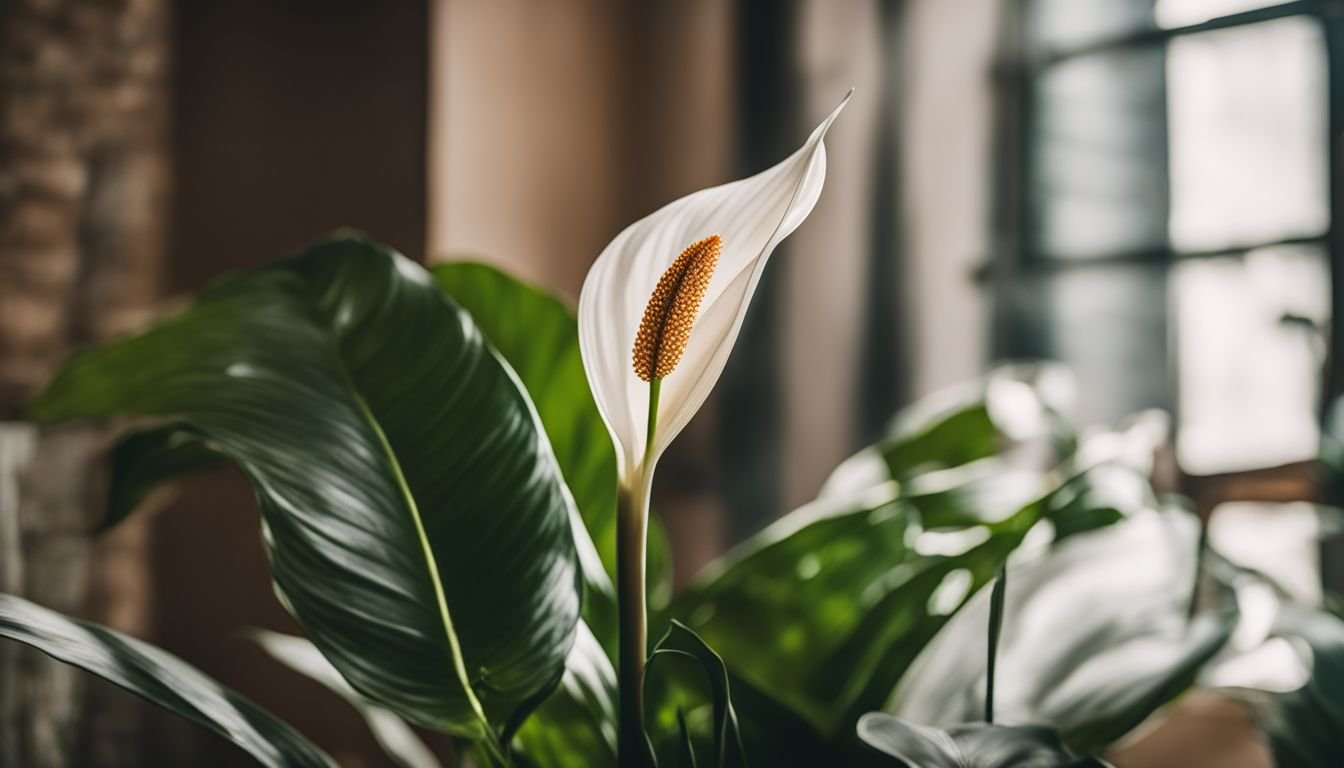Ever noticed your peace lily’s once cheery blooms turning a sorry shade of brown? You’re definitely not the only one. A fair few Aussie plant enthusiasts find themselves scratching their heads over this, wondering what went wrong.
It can be pretty gutting to watch those gorgeous flowers go drab on you. More often than not, getting a bit too generous with the watering can or forgetting it altogether are usually behind these browning blossoms.
No worries, though! After having a good dig into some gardening know-how and yarns with a couple of experts, we’ve managed to rustle up some top-notch advice to nurse your peace lily back to health.
Our guide is chock-full of tips for pinpointing why your flowers are going brown – be it from too much water, not enough light, or even nutrient overload – along with simple fixes.
Getting your indoor green space looking lush again might be more straightforward than you reckon.
Keen to give your peace lily a new lease on life? Let’s crack on!
Key Takeaways
- Check the soil moisture before watering your peace lily to avoid both over-watering and under-watering. If the top layer of soil is dry, it’s time for a drink; if it’s damp, wait a bit longer.
- Place your peace lily in an area with indirect sunlight to protect its leaves and flowers from getting scorched or weakened. Bright, but not direct, light helps maintain healthy blooms.
- Feed your peace lily liquid fertiliser every six weeks at half the recommended strength to prevent fertiliser burn. Too many nutrients can overwhelm the roots leading to brown-tipped leaves.
- Regularly prune spent blooms from your peace lily to stimulate new growth and flowering. Removing old flowers makes way for fresh ones and keeps the plant looking vibrant.
- Use filtered water for irrigating your peace lily as tap water may contain minerals that could harm the plant. Keeping a consistent watering schedule based on checking soil moisture can protect against root rot and promote flourishing blooms.
Why Does Peace Lily Flowers Turn Brown?

Peace Lily flowers might turn a shade of brown for several reasons. These include too much or too little water, not getting the right amount of light, harm from plant feed, and simply because they’re getting old.
Over-Watering or Under-Watering
Getting watering just right plays a huge part in the health of our peace lilies. Too much water leads to root rot, a serious issue where roots can’t take up nutrients or water because they’re damaged.
This often turns flowers brown and can kill the plant if we don’t act fast. On the flip side, not enough water means our indoor plants struggle to stay hydrated. Their leaves might droop, and their once vibrant blooms turn brown as they dry out.
We need to check the soil moisture before deciding to water again. If the top layer feels dry, it’s time for a drink; but if it’s damp, we wait a bit longer. Using well-draining potting mix helps prevent excess water from pooling around roots.
Ensuring pots have proper drains also reduces risks of over-watering.
“A thirsty plant is easy to quench, but once drowned, its chances sink.”
After addressing watering issues, let’s shine some light on another crucial aspect: lighting conditions for our peace lilies.
Incorrect Light Conditions
We know how frustrating it can be to see the flowers of your peace lily turning brown. Often, this issue comes down to not getting the light conditions right. Too much sunlight scorches leaves and flowers, leaving you with unattractive brown blooms.
On the flip side, not enough light leads to yellow leaves and weak blossoms that fail to thrive.
Ensuring your plant gets just the perfect amount of brightness is vital for keeping those flowers healthy. Place your peace lily in a spot where it can enjoy indirect sunlight. Direct rays from the sun are too harsh for these tender plants.
If finding a naturally well-lit area proves difficult, consider using artificial lights designed for houseplants. These mimic natural light and help prevent problems like chlorosis, which can lead to browning if left unchecked.
Moreover, keeping an eye on your plant’s environment will pay off greatly. As lovers of high humidity and stable conditions, peace lilies flourish when their surroundings match their needs closely.
Fertiliser Burn
Giving your peace lilies just the right amount of plant food is crucial. Too much can cause what we call fertiliser burn. This happens because the roots get overwhelmed by too many nutrients, leading to brown-tipped leaves.
We stick to a schedule of feeding our plants liquid nourishment every six weeks at half the strength suggested on the package. This method helps prevent overfeeding and keeps our house plants healthy and happy.
Caring for these beautiful indoor plants means watching out for signs of distress like brown flowers or leaves. If you notice such symptoms shortly after applying fertiliser, it might be a signal that you’ve gone overboard with plant food.
Cutting back on how much and how often you feed your peace lily can quickly remedy this issue. Keep an eye out for any improvements in leaf colour and overall health after adjusting your routine.
Ageing Blooms
While taking care of our peace lilies, we often forget that just like fertiliser burn can harm them, nature has its own course too. Blooms age and this is a completely natural part of their lifecycle.
Our lovely peace lily flowers can’t stay vibrant forever. They usually last around 10 days before they start showing signs of ageing, such as turning brown and wilting. This doesn’t mean we’ve failed in caring for them; it’s simply how these plants operate.
Pruning these spent blooms regularly helps the plant focus its energy on new growth and flowering. It’s not about removing something bad but rather making room for more beauty to emerge.
Prune carefully, leaving the rest of the plant undisturbed.
“In every change, in every falling leaf there is some pain, some beauty. And that’s the way new leaves grow.”
How to Keep Peace Lily Flowers from Turning Brown

To stop your Peace Lily blooms from going brown, take care of them with a keen eye and tender hands. Start by checking how much you water them and where they sit in your home. Just the right amount of sunlight and a light touch with plant food can make all the difference.
Don’t forget to snip off flowers that have done their bit. By paying close attention to these steps, your Peace Lilies will stay healthy and vibrant for everyone to enjoy. Keep reading to learn more about keeping your favorite plants in top shape!
Monitor Watering
We all know peace lilies need the right amount of water to thrive, but finding that balance can be tricky. Using filtered water makes a huge difference. This simple step keeps harmful minerals away from your plants and helps prevent brown flowers.
Also, setting a schedule to hydrate your peace lilies every six weeks is key to keeping those blooms fresh and vibrant.
Checking the soil before watering adds an extra layer of care. If the top inch feels dry, it’s time for a drink; if not, hold off until it does. Peace lilies enjoy dappled sunlight rather than direct rays which mimic their natural rainforest habitat.
This kind of light supports healthy growth without speeding up soil drying too much.
Lastly, keep an eye out for signs of distress outside regular checks. Drooping leaves or dry tips mean your plant could use more hydration or better drainage to avoid root rot caused by excess moisture–a major enemy for these sensitive beauties.
Whether you’re an experienced horticulturalist or just starting in garden design, paying close attention to how and when you water will make all the difference in keeping your peace lily looking its best.
Provide Proper Light
After making sure our peace lilies receive just the right amount of water, we also need to ensure they enjoy the perfect light settings. Peace lilies thrive in dappled sunlight. This means placing them where the sun’s rays touch them gently through a curtain or blinds.
Direct sunlight can harm their delicate leaves and flowers, causing them to brown. Keeping them in bright, indirect light will keep their leaves glossy and flowers vibrant.
We make it a point to maintain temperatures around 70 degrees Fahrenheit or higher for our peace lilies because this warmth supports their health and flower longevity. It’s crucial not to put these plants near cold drafts or directly under air conditioners.
Their love for warm, consistent conditions makes finding that sweet spot in your home important – perhaps near a window that gets plenty of morning sun but is shielded from the harsh afternoon glare.
“Placing your peace lily in dappled sunlight is like giving it a cosy blanket; you protect it while encouraging growth.”
Use Fertiliser Sparingly
Just as the right amount of sunlight does wonders, so does the careful use of plant food. We know that peace lilies enjoy a bit of help to bloom beautifully. But it’s about finding that sweet spot.
Applying half the recommended dose of liquid feed every six weeks is enough. This method encourages our flowers without risking damage from too many minerals.
We also mix in a slight bit of gibberellic acid occasionally to boost flowering. It’s all about balance – providing just what our plants need and nothing more. Overdoing it can lead to brown tips or worse, root harm due to excess nutrients accumulating in the soil potting mix, which could attract mold or fungal illnesses.
So, we use these helpers sparingly and watch as our peace lilies thrive with just enough nutrition.
Regularly Remove Spent Blooms
We often find ourselves eagerly cutting off brown flowers from our peace lilies. This process, known as deadheading, directs the plant’s energy towards sprouting new, vibrant blooms.
It’s crucial because it stops the plant from wasting resources on maintaining those spent blossoms. As a result, not only does this practice extend the life of your peace lily flowers, but it also keeps them looking fresh and lively.
Cutting back these wilted parts prevents potential issues such as fungal diseases or mold growth on dead tissue. Tools like sharp scissors or secateurs make this job easy and precise.
Ensuring cleanliness with these tools is vital to avoid introducing any infections to your precious plants.
Furthermore, this method stimulates more than just visual appeal; it promotes healthier growth overall. So next time you spot a brown flower on your peace lily, grab those scissors and give the plant a little trim.
This simple act can lead to a big difference in how lush and healthy your peace lily appears throughout its blooming cycles.
Maintaining Your Peace Lily for Optimal Health
Keeping your Peace Lily in top shape requires ongoing care. We should give them the right amount of water and keep the air around them moist. It’s also key to cut off old blossoms and leaves to help the plant stay healthy.
This way, our Peace Lilies will thrive, showing off their lush green leaves and stunning white blooms.
Water Wisely
We always recommend using filtered water for your peace lily because tap water often contains minerals that can harm the plant. Make sure you’re watering with care to prevent any damage to your beloved green buddy.
This practice shields the plant from unwanted salts and chemicals that might accumulate in the soil, which can lead to issues.
For best results, observe your peace lily’s moisture needs closely. The soil should be moist but not soggy. Check by pressing a finger into the soil; if it feels dry an inch below the surface, it’s time for a drink.
Don’t let the plant sit in water as this could lead to root rot, an adversary of many indoor plants including ours. It’s crucial for their health and vibrant blooms that we get this balance right.
Maintain Consistent Humidity
To keep our peace lilies thriving, we make sure they live in an environment with humidity levels between 40-60%. This range is crucial for their health. To achieve this, we use humidifiers or place the pots on trays filled with stones and water.
These methods add moisture to the air around our plants, preventing their flowers from turning brown and keeping the leaves from wilting or yellowing.
We also pay attention to daily changes in weather and indoor heating or cooling that can affect air moisture. If we notice the air getting drier, we adjust by adding more water to the pebble trays or turning up our humidifiers.
Keeping a steady level of humidity ensures our peace lilies stay healthy and beautiful, showing off lush green leaves and stunning white flowers year-round.
Regular Pruning
Regular pruning keeps our peace lily in top shape. We cut off dead or brown blooms to help the plant focus on growing fresh, healthy ones. This process, called deadheading, stops the plant from wasting energy on parts that are no longer useful.
It’s a bit like cleaning out our closets – getting rid of what we don’t need makes room for new things.
We also take time each week to check for any yellowing or damaged leaves and snip them off with scissors. This not only tidies up the plant but encourages new growth as well. Think of it as giving our peace lily a quick health check-up and makeover at the same time.
Using insecticidal soap helps fight off any pests that might cause harm during this process, ensuring our peace lilies stay bug-free and beautiful. Plus, applying liquid fertiliser every now and then gives an extra boost to support all the new growth encouraged by regular trimming.
Conclusion
Keep your peace lily blooming beautifully by tackling brown flowers head-on. We’ve covered the common causes including watering mistakes, not enough or too much sunlight, and issues with plant food burns.
Fixing these is straightforward: check your watering routine, ensure the right amount of light, and be careful with houseplant nutrition application. Don’t forget to snip off any old blooms to help your plant focus on sprouting fresh ones.
Keeping a peace lily healthy might seem like a lot at first, but once you get into the groove, it’s really quite simple. Your efforts will pay off when you see that lush green foliage and stunning white blooms thriving under your care.
FAQs
1. Why does my Peace Lily have brown flowers?
Your Peace Lily might have brown flowers due to overfertilisation, especially if you’re using too much liquid fertiliser, or because of underwatering and low humidity.
2. How can I prevent the flowers on my Peace Lily from turning brown?
To prevent your Peace Lily’s flowers from turning brown, make sure to water it regularly without overdoing it and use liquid fertiliser sparingly according to the recommended dosage.
3. Can I fix a Peace Lily with brown flowers?
Yes, you can try to revive your plant by trimming off the brown parts of the flowers gently, adjusting your watering habits, and ensuring you’re not applying too much liquid fertiliser.
4. Is it normal for a Peace Lily flower to turn brown after blooming?
It’s natural for a flower to eventually die off and turn brown after its blooming cycle is complete; however, premature browning may indicate care issues such as improper use of liquid fertiliser or inadequate watering.
